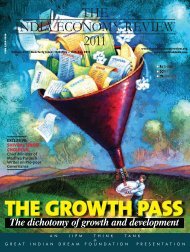Download - The India Economy Review
Download - The India Economy Review
Download - The India Economy Review
You also want an ePaper? Increase the reach of your titles
YUMPU automatically turns print PDFs into web optimized ePapers that Google loves.
P LANNING P ARADIGM<br />
achieving “more even distribution of<br />
power”. <strong>The</strong>se, without doubt, were desir-<br />
able goals but these depended very heavily<br />
on role and effi ciency of public sector<br />
enterprises. (PSEs) which were expected<br />
to generate adequate surpluses consistently<br />
and plough it back through fresh<br />
investments in desired sectors. <strong>The</strong> system<br />
of industrial licenses was to be a<br />
means to prevent concentration of income<br />
and wealth. Subsequent studies, however,<br />
revealed that the very system helped large<br />
industrial houses to corner licenses and<br />
help retain their monopoly status.<br />
After successful First Five Year Plan,<br />
the Second Five Year Plan unveiled a<br />
strategy of accelerated development<br />
through development of heavy & capital<br />
intensive industries. This disturbed the<br />
initial consensus about the planning process.<br />
Brahmananda & Vakil, inter alia,<br />
argued the need to accord priority for<br />
agriculture, instead of heavy & capital<br />
goods industries, so that supply of wage<br />
goods could be enlarged. <strong>The</strong> underachievement<br />
of the planning process was<br />
refl ected in slower than targeted growth<br />
during the third fi ve year plan period<br />
(Table 1). This coupled with two wars and<br />
a severe draught necessitated a plan holiday<br />
for three years. Planning resumed in<br />
1969 when Fourth Five Year Plan was<br />
launched. But there were two other occasions<br />
(in 1979-80 and 1990-91) when Five<br />
Year Plans were replaced by Annual<br />
Plans. (Table 1).<br />
Centralized planning process in a diverse<br />
country like <strong>India</strong> with a federal<br />
constitution should be considered little bit<br />
anachronistic. In 1972 Planning Commission<br />
advised state governments to set up<br />
state planning boards as apex planning<br />
bodies with chief Minister as the chairmen<br />
and the fi nance minister, Planning<br />
76 THE IIPM THINK TANK<br />
Table 1 : <strong>India</strong>n <strong>Economy</strong> Planned vs. Actual Growth<br />
Target ( % p. a. ) Actual (% p. a. )<br />
First ( 1951-56) 2.1 3.5<br />
Second (1956-61) 4.5 4.2<br />
Third ( 1961-66) 5.6 2.8<br />
Annual Plans (66-69) - 3.9<br />
Fourth ( 1969-74) 5.7 3.2<br />
Fifth ( 74-79) 4.4 4.7<br />
Annual Plan (1979-80) - -5.2<br />
Sixth (1980-85) 5.2 5.5<br />
Seventh (1985-90) 5 5.6<br />
Annual Plan (90-91) - 3.4<br />
Eighth (1992-97) 5.6 6.5<br />
Ninth 6.5 5.5<br />
Tenth (2002-07) 7.9 7.7<br />
Eleventh Plan (2007-12) 9 ?<br />
Source: Eleventh Five Year Plan Vol. 1<br />
Minister and technical experts representing<br />
various departments and disciplines<br />
as members. This scheme envisaged decentralization<br />
of planning process to the<br />
district and ultimately block level. While<br />
decentralization has taken some roots at<br />
the state level, further decentralization to<br />
lower levels of governments, notwithstanding<br />
constitutional amendments to<br />
strengthen Panchayat Raj institutions,<br />
remains an unachieved goal.<br />
Persistent lackluster growth performance<br />
of the <strong>India</strong>n <strong>Economy</strong> during 1960s<br />
and 1970s drew critical attention to shortfalls<br />
in planning process & development<br />
policies pursued by Government of <strong>India</strong>.<br />
Spectacular growth performance by<br />
other countries, the so called Asian tigers<br />
in particular, led to demands for shift<br />
from closed economy approach and its<br />
substitution by an export oriented outward<br />
looking approach giving more lee<br />
way to private initiatives and competitive<br />
markets. A variety of critiques of planning<br />
experiences in <strong>India</strong>, in particular, and<br />
prescriptions for future improvements in<br />
it are refl ected in Ahluwalia, Bardhan,<br />
Chakravarty and Patnaik.<br />
Over the years, economic policies have<br />
become more open, market oriented and<br />
private sector friendly particularly since<br />
mid 1980s. <strong>The</strong>re have been signifi cant<br />
shifts in the thinking about the role of<br />
public sector. <strong>The</strong> actual performance of<br />
PSEs has not been as expected. As a result,<br />
desired higher share of public sector<br />
investment was not achieved. Moreover,<br />
the need to maintain the fi scal balance<br />
has reduced the ability of the government<br />
to commit additional resources at the<br />
disposal of PSEs. This became another<br />
reason to encourage private and foreign<br />
investments in several sectors hitherto<br />
reserved for PSEs.<br />
As refl ected in Table 2 relative contribution<br />
of Public sector investment has<br />
reduced signifi cantly over the years. This<br />
has eroded numerical primacy of public<br />
sector investment. Plan exercises were<br />
primarily for public sector component of<br />
plan investment. Less than satisfactory<br />
performance of Public sector units has<br />
not only adversely affected target growth<br />
rate and investment pattern but also<br />
dented the Planning Commission’s ability<br />
to prepare an effective plan. Notwith-





